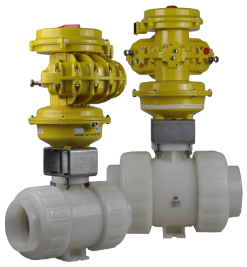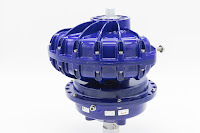 |
| Thermoplastic valves with corrosion resistant actuators, springs and positioners. (Kinetrol) |
Thoughtful actuator selection is required when plastic valves are specified. While the mechanics in applying pneumatic actuators to plastic quarter-turn valves is no different than metallic valves, the characteristics of the process and application can have significant impact on the performance the automated valve.
The assumption is that, if a thermoplastic valve is required, there is an higher probability the of exposure to corrosive media, or the automated valve assembly is located in a corrosive atmosphere, and therefore a corrosion resistant pneumatic actuator is preferred. Considering this, an actuator with internal and external parts protected by epoxy resins or special paints should be applied. Additionally, actuator spring systems should be designed in way to prevent exposure to corrosive media.
 |
| Corrosion resistant rotary vane actuator with special external coating. (Kinetrol Blueline). |
The rotary vane actuators manufactured by Kinetrol standardly meet theses requirements. Engineered specifically for high-cycle, dirty, and corrosive applications, these very hardy, compact actuators come standardly with an epoxy stove enamel finish, stainless steel internal and external hardware, with spring units that are totally sealed from the atmospheric contaminants. For applications requiring greater corrosion resistance, such as caustic wash-down or salt-laden environments, an optional "Blueline" coating can be applied,